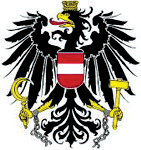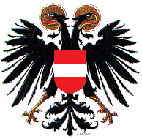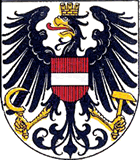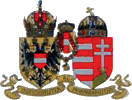Austrian Coat of Arms since 1945
 On 1 May 1945 the Coat of Arms of the First Republic was reintroduced. The symbols of hammer, sickle and the mural crown embellishing the eagle’s head represent peasantry, workers and bourgeoisie. The broken iron chain symbolizes the restoration of the Austrian independence and the state in 1945.
On 1 May 1945 the Coat of Arms of the First Republic was reintroduced. The symbols of hammer, sickle and the mural crown embellishing the eagle’s head represent peasantry, workers and bourgeoisie. The broken iron chain symbolizes the restoration of the Austrian independence and the state in 1945.Austrian Coat of Arms (1934-1938)
 During the authoritarian period of the first Austrian Republic, a black double-headed haloed eagle with a shield was used, but without the other 3 symbols. With the double-headed eagle one wanted to draw on old Austrian traditions. The haloed eagle’s heads can be interpreted as a symbol of the Christian Catholic orientation of the state. During the rule of National Socialism the Austrian national symbols were forbidden.
During the authoritarian period of the first Austrian Republic, a black double-headed haloed eagle with a shield was used, but without the other 3 symbols. With the double-headed eagle one wanted to draw on old Austrian traditions. The haloed eagle’s heads can be interpreted as a symbol of the Christian Catholic orientation of the state. During the rule of National Socialism the Austrian national symbols were forbidden.Coat of Arms of Republic of German Austria (1919-1934)
 The eagle wears a golden mural crown with three visible battlements and holds a golden sickle and a golden hammer in its pounces. Sickle and hammer represent economically active people, and the civic crown is considered the sign of democracy.
The eagle wears a golden mural crown with three visible battlements and holds a golden sickle and a golden hammer in its pounces. Sickle and hammer represent economically active people, and the civic crown is considered the sign of democracy.Austro-Hungarian Coat of Arms 1915
 The Coat of Arms connects Kingdoms and Lands represented in the Imperial Council (cisleithanic half of the empire, Austrian states) and the lands of the crown of St. Stephan (transleithan half of the empire, Hungarian lands) in a national and heraldic way. The small coat of arms of the Austrian lands became the ancestor of today’s National coat of Arms.
The Coat of Arms connects Kingdoms and Lands represented in the Imperial Council (cisleithanic half of the empire, Austrian states) and the lands of the crown of St. Stephan (transleithan half of the empire, Hungarian lands) in a national and heraldic way. The small coat of arms of the Austrian lands became the ancestor of today’s National coat of Arms.
